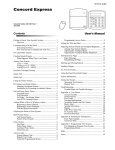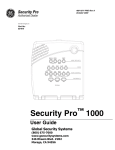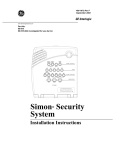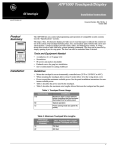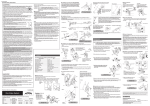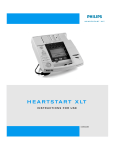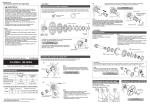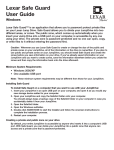Download Allegro User Manual Rev A
Transcript
ITI Part No. 60-874-95 $OOHJUR Document Number: 466-1822 Rev. A April 2002 Contents Getting to Know Your Security System ........................... 1 Overview ...................................................................1 Communicating with the Panel ........................................ 1 Instructing the Panel ................................................. 1 User Interface ............................................................ 1 Wireless Touchpad ............................................... 1 Keychain Touchpad .............................................1 Beeps and LEDs— How Your System Talks to You 1 Key Beeps ............................................................ 1 Status Beeps ......................................................... 2 LEDs .................................................................... 2 Alarms .............................................................................. 2 What Happens in an Alarm Condition ......................2 Siren Time-out ..................................................... 2 Preventing Accidental Alarms .................................. 2 Aborting Accidental Alarms ..................................... 2 Guidelines for Preventing Accidental Alarms .....2 Panic Alarms ............................................................. 3 Police Panic Alarm .............................................. 3 Fire Panic Alarm .................................................. 3 8VHU·V0DQXDO 6 0 8 7 4 9 5 g 1 0 a .d s f Programming Your System ..............................................8 Panel Button Programming Functions ......................8 Access Codes ............................................................8 Primary User Code ...............................................8 User Code .............................................................8 Setting the Time ........................................................9 Adjusting the Panel Beep Volume ............................9 Version ......................................................................9 Testing the System ...........................................................9 Automatic Test Features ............................................9 Manual Tests .............................................................9 Sensor Test ...........................................................9 If a Wireless Sensor Does Not Test Successfully ....................................................10 Phone Communication Test ...............................10 Testing Central Station Communication ............10 Exiting User Programming Mode ......................10 Trouble Beeps and Trouble Messages ............................10 Silencing Trouble Beeps .........................................10 Appendix A: Troubleshooting ........................................ 11 Basic System Operations ................................................. 3 Arming and Disarming Your System ........................ 4 Level 1—Disarmed .......................................................... 4 Level 3—Doors, Windows, and Motions ......................... 4 Level 2—Doors and Windows ......................................... 4 Arming Level 1—Disarmed ................................ 4 Arming Level 2—Doors and Windows ............... 4 Arming Level 3—Doors, Windows, and Motions ......................................................... 4 Arming Options ........................................................5 Quick Arm ........................................................... 5 Keychain Touchpad Arming ................................ 5 Quick Exit ............................................................ 5 Chime Feature ...................................................... 5 Exit and Entry Delay Times ................................. 5 Exit Delay Example .......................................... 5 Entry Delay Example .......................................5 Silent Exit ............................................................ 6 Exit Extension ...................................................... 6 No Delay—For Instant Alarm ............................. 6 Auto STAY Arm .................................................. 6 Arming While a Door or Window is Open .......... 6 Direct Bypass .................................................... 7 Indirect Bypassing ............................................ 7 Was the Bypass Successful? ............................. 7 Checking the Status of Your System ......................... 7 Appendix B: User Reference ..........................................13 System Information .................................................13 User Codes ..............................................................13 Keychain Touchpads ...............................................13 Accidental Smoke and Fire Alarms ........................13 Dialer Dly ................................................................13 Entry and Exit Delay Time Settings ........................13 Automatic Phone Test .............................................13 Sensor Log ..............................................................14 If the Power Goes Out .............................................15 Conditions, Displays and Sounds ............................15 Siren ........................................................................17 Trouble Beeps .........................................................17 Appendix C: Planning for Emergencies .........................18 Your Floor Plan .......................................................18 Alarm System Limitations ......................................18 If Your System Needs Service ................................19 Notices ....................................................................19 Getting to Know Your Security System This security system is designed to protect your family and property, whether you are on the premises or away. This manual describes how to operate your system. It describes basic arming and disarming commands as well as programming instructions for system features. The dealer or installer may have already discussed with you many details concerning your system. Specific setup information is included in “Appendix B: User Reference” on page 13. Instructing the Panel Most of your instructions to the panel consist of this basic pattern: COMMAND + ACCESS CODE Not just anyone can walk up to a touchpad and operate your security system. Before the system will process most commands, users are required to enter a pre-programmed 4-digit access code. Keychain touchpads do not require an access code and are usually kept in an individual’s pocket or purse. User Interface Overview Your security system is comprised of different components. Each component plays a special role in system operation: The panel is at the heart of your system. It stores the intelligence to monitor all the sensors and devices in the system. The panel is the piece of equipment that initiates a call to the central station in an alarm situation. The panel has a touchpad for arming, disarming, checking status and entering data, such as access codes. The panel uses a liquid crystal display (LCD) to communicate system status information. The display is comprised of icons and nine twelve-segment characters for displaying messages. If a message is longer than nine characters, the first nine characters are displayed and the rest of the message scrolls through in a marquee fashion. In addition to the Allegro panel touchpad, there are two other types of touchpads that can be used with your panel. Wireless Touchpad This touchpad is wireless and can be carried from room to room. S Y S T E M S T A T U S A R M D o o rs & W in d o w s Dialog Telephone Interface Module (DTIM) provides added security by separating the telephone interface from the panel. If the panel is damaged by fire or a break-in, it still reports to the central monitoring station. Door and window sensors protect the perimeter of your home by alerting the panel when a door or window is opened. Motion detectors in hallways or individual rooms detect a person moving across the field of detection. Environmental sensors such as smoke and carbon monoxide detectors remain alert for the presence of fire or carbon monoxide 24 hours a day. A R M M o t io n S e n s o rs Note D IS A R M 2 1 5 4 7 The Light Buttons do not work on Allegro Systems. 3 8 O n 6 9 O ff E M E R G E N C Y - P re s s & H o ld B o th K e y s Keychain Touchpad Keychain touchpads are handy for simple arming and disarming functions. They are wireless and can be carried offsite in a purse or pocket. The installer can program the touchpad to send a Police or Emergency panic alarm. Note If an alarm is initiated with this device, a different device must be used to disarm the system. Beeps and LEDs— How Your System Talks to You Communicating with the Panel The panel siren produces a variety of operating beeps to inform you of different system states and operations. Touchpads allow you to communicate with the panel. In turn, the system can be set up to communicate with you through: Key Beeps ❑ ❑ ❑ Status beeps from the panel speaker. Alarm sirens. Icons and scrolling text on the display. Allegro User’s Manual A key beep is the tone you hear when you press a button on the panel or handheld wireless touchpad. The sound confirms that the button was adequately pressed. 1 Status Beeps Siren Time-out Status beeps come from the siren on the panel and are sounded when there is a change in the current status of the system. Status beeps are not alarms, but they do warrant your attention. If the system is not disarmed after an alarm, the sirens will continue to sound until the time-out period is reached. The time-out period can only be programmed by your installer or dealer. There is more than one type of status beep: Even though reaching the time-out stops the sirens, the alarm will still be in progress and will remain so until the system is manually disarmed. ❑ ❑ ❑ ❑ ❑ ❑ Exit Delay beeps indicate that an arming command has been entered and the countdown to arming has begun. Exit and close the door behind you before the exit delay expires. Entry Delay beeps indicate that you’ve entered the building and the countdown to an alarm has begun. Disarm the system as soon as you get in. Chime feature beeps tell you that a door was opened. Protest beeps inform you that you’re trying to arm the system while there is an open door or window. Trouble beeps tell you that there is a problem with the system or one of its components. Sensor test beeps are the sounds the system makes during a sensor test to indicate the number of packets the panel received. Status beeps are described in more detail throughout the manual and in “Appendix B: User Reference” on page 13. LEDs The touchpad has two LEDs which allow you to determine the current system status at a glance. The red LED is labeled Armed and the green LED is labeled Ready. The table below explains LED behavior. System Status Exit Delay Red Armed LED Flashing Green Ready LED Preventing Accidental Alarms Your security system is engineered with advanced technology that reduces the chance of an accidental alarm caused by a technical problem. Most accidental alarms occur when leaving the residence after arming the system, or upon returning, before disarming the system. If, for example, you arm the system, then run to another room for something you forgot, the Exit Delay time may expire. Once the Exit Delay expires, opening an armed door or moving in front of an armed motion detector will cause an alarm or start the entry delay. Aborting Accidental Alarms Your system can be set up with the opportunity to abort an accidental intrusion, Police, or Emergency alarm (fire alarms cannot be aborted). If the Dialer Delay feature is turned on, you have a programmed amount of time (within 30 seconds of event, or as set by your installer) to stop the panel before it sends a false alarm to the central station. Talk to your installer or see Appendix B: User Reference under “Dialer Dly” on page 13 to see if this feature is enabled. On or Off Fire alarms are always reported. If an accidental fire alarm has sounded, follow the procedures of your central monitoring station to prevent a false dispatch. Armed to Level 1-Disarmed Off On or Off Armed to Level 2—Doors On and Windows or 3—Doors, Windows, and Motions On or Off Entry Delay Flashing On or Off 1. Panel displays ENTER CODE + type of alarm. System Trouble (check system status)/Protest On or Off Off 2. Enter your access code. System OK On, Off or Flashing On To abort a non-fire alarm: The panel displays ABORTED and sounds one beep. Alarms What Happens in an Alarm Condition Guidelines for Preventing Accidental Alarms Following these guidelines will go a long way toward preventing accidental alarms. ❑ When there is an alarm condition, the following happens: ❑ ❑ ❑ ❑ The siren emits emergency tones. Panel notifies the central station for help. ❑ 2 Close doors and windows before you arm your system and leave your house. When getting ready to leave the house, gather the things you want to take with you so you can exit immediately after arming the system. Always enter and exit within the programmed delay times. Make sure you leave through a door that has a delay time set for it. If you arm your system, then leave through a door without a delay time, the siren will Allegro User’s Manual ❑ ❑ ❑ ❑ ❑ immediately sound the alarm condition. When you return immediately disarm your system. Talk to the system installer to be aware of the devices in your security system and learn how each one operates. Listen to system beeps. Take note of indicator lights and touchpad messages which indicate the current system status. If you have pets, ask your installer if you need pet lenses in your motion detectors or pet immune motion sensors. Pets climb higher than you may guess, causing alarms when you are away. Check the location of your smoke detectors. Smoke detectors near bathrooms can be tripped by steam from a shower. Smoke detectors near the kitchen can be tripped by excessive smoke from cooking. These alarms cannot be aborted and are always reported to the central station. Since many communities charge for dispatching the fire department in error, your dealer may give you specific instructions to follow in the event of an accidental smoke or fire alarm. Record these instructions in Appendix B under “Accidental Smoke and Fire Alarms.” To activate a Fire panic alarm from the panel: ❑ Press and hold both responds. Basic System Operations Table 1 describes the system’s basic panel keypad operating commands. Table 1: Basic Panel Operating Commands How to... Panic Alarms Panic alarms are easily activated from any touchpad to quickly alert the central monitoring station to a Fire or Police emergency. A panic alarm can be sent at any time, regardless of the current arming level. This system is designed to inform a central monitoring station of the nature of the emergency so the correct personnel can be dispatched immediately. Each type of panic alarm sounds and reacts differently when activated. Type of Alarm Alarm Sound Police Continuous tone Fire Repeating series of three beeps Check system status. Disarm Arms doors and windows. Press and hold the the panel responds. 1 Police buttons until Press and hold the responds. To activate a Police panic alarm from a keychain touchpad: ❑ Press and hold the Lock and the same time for 2 seconds. Unlock buttons at Fire Panic Alarm If your system includes smoke and fire detectors, it monitors the premises for smoke and fire alarms 24 hours a day and in all arming levels. Allegro User’s Manual A rm + Code Arms motions, doors, and windows, no delay. A rm Arms system silently. Turns chime feature on and off (only when system is unarmed). Identifies alarms in memory. Bypass Police buttons until the panel + Code A rm To activate a Police panic alarm from the wireless touchpad: ❑ Press once Arms motions, doors, and windows. Police Panic Alarm To activate a Police panicA r m alarm from the panel: * D is a r m A rm Arms motions, doors, and windows. The Police panic alarm sounds to scare off any intruder and alert neighbors to any trouble. On monitored systems, the central monitoring station responds by calling the police. Command S ta tu s Arms doors and windows, no delay. Arms doors and windows. ❑ Fire buttons until the panel N o D e la y (twice) + Code N o D e la y (twice) + Code + 4 A rm Press once if quick arm is on A rm Press twice if quick arm is on A rm S ile n t + C h im e 7 S ta tu s * + Code Press once Press once B y p a s s # Q u ic k E x it Quick Exit + Primary Code Press once, starts a 2 minute timer for use of one entry/exit door. Press and hold both buttons until panel indicates alarm. A rm 1 Police Panic S ile n t Fire Panic 4 + Code + C h im e 7 Press and hold both buttons until panel indicates alarm. 3 Arming and Disarming Your System To disarm to Level 1 using the panel keypad: Since your security needs may vary throughout the day, this system was designed with three arming levels to meet these different needs. By arming your system to a particular level, only those sensors programmed to detect in that arming level will report alarm conditions to the panel. 1. Press once. The panel displays Enter Code TO DISARM. 2. Enter your access code. The panel displays the current time and the system sounds one beep. To disarm to Level 1 using a keychain touchpad: No matter which level your system is in, all sensors programmed to be active 24 hours a day will continue to report alarm conditions. This includes smoke detectors, fire sensors, panic buttons, and environmental sensors. /HYHO³'RRUV:LQGRZVDQG0RWLRQV All perimeter and interior sensors are active. /HYHO³'RRUVDQG:LQGRZV Perimeter protection is on. Interior sensors are not active so people and pets can move around freely. ❑ Press the button. To disarm to Level 1 using a wireless touchpad: 1. Press the DISARM button. 2. Enter your access code. Arming Level 2—Doors and Windows There are times when you want intrusion protection, but still want the freedom to move around within your house without setting off an alarm. For example, in the evening when your family is inside for the night. In this and similar situations, set your system to Level 2. Note Smoke detectors, fire sensors, and other environmental sensors continue to report alarms in all levels. To arm to Level 2 from Level 3, you must first disarm the system and then rearm it. /HYHO³'LVDUPHG Intrusion detection off. Smoke, heat, and environmental sensors remain active. Arming Level 1—Disarmed To arm to Level 2 using the panel keypad: 1. Close all protected perimeter doors and windows. 2. Press 3. Enter your access code. The panel displays the current time and Doors and Windows. The system sounds two beeps. Turn off intrusion/burglary protection for your system when security is not a concern. This would be when you are home and will be going both inside and out. Sensors that will remain active: ❑ Environmental sensors (smoke, heat, carbon monoxide). Sensors that will be inactive: ❑ ❑ Indoor motion sensors. Perimeter sensors such as doors and windows. Here are some other situations in which you’d set the system to Level 1: ❑ ❑ ❑ Upon entering your armed home or business. When entering the armed premises through a designated delay door, the Entry Delay time begins. The siren beeps to remind you to disarm the system. Before opening a door or window in your home or business. When you wake up in the morning and want to get your newspaper, you must disarm the system before opening the door to prevent an accidental alarm. Disarming the system turns off any sirens when an alarm condition occurs. once. The panel displays Enter Code TO ARM. Note If Quick Arm feature is on, an access code is not required to arm the system to Level 2. 4. If leaving the premises, exit through a designated delay door before the delay time expires. To arm to Level 2 using a keychain touchpad: ❑ Press the button. Note See Keychain touchpad arming section. To arm to Level 2 using a wireless touchpad: 1. Press Arm Doors and Windows button. 2. Enter your access code. Arming Level 3—Doors, Windows, and Motions At other times, you want every sensor to be alert, such as when the family goes on vacation, or at business closing time. In this and similar situations, set your system to Level 3 for maximum protection. All sensors are active—perimeter door and window sensors and interior motion detectors. To arm to Level 3 using the panel keypad: 1. Close all perimeter doors and windows. 2. Press 4 twice. The panel displays, Enter Code TO ARM. Allegro User’s Manual 3. Enter your access code. The panel displays the current time and Motion Sensors, Doors and Windows. The system sounds three short beeps. 4. Exit through a designated delay door before the delay time expires. Note If Quick Arm feature is on, an access code is not required to arm the system to Level 3. To use Quick Exit: 1. When the system is armed to Level 2 or 3, press the Quick Exit button. The panel displays QUICK 120, and begins the 2 minute countdown. 2. Open door and exit. 3. Come back in within the two minutes and close the door. The system will rearm after 2 minutes. To arm to Level 3 using a keychain touchpad: Chime Feature ❑ When this feature is on, opening a door or window will cause the panel to beep twice and display the sensor’s name. Press the button twice to go from Level 1 to Level 3, or once to go from Level 2 to Level 3. Note See Keychain touchpad arming section for other arming options. To arm to Level 3 using a wireless touchpad: 1. Press the ARM Motion Sensors button. To set chime feature on or off: Press the chime button to turn the chime feature on or off. When on, the panel will alternate between displaying the current time and CHIME ON. 2. Enter your access code (if required). Note Chime feature can only be turned on or off when in Level 1. Arming Options Exit and Entry Delay Times Quick Arm The Quick Arm option lets you arm your system without using an access code. You will still need to enter an access code to disarm the system. Contact your installer if you’d like to use this feature. To arm to Level 2 with Quick Arm enabled: ❑ Press Press button twice. Keychain Touchpad Arming Your installer can set up your keychain touchpad to arm the system in one of two ways: ❑ ❑ ❑ button once. To arm to Level 3 with Quick Arm enabled: ❑ After arming your system, you need time to exit the building so you won’t set off an alarm. Likewise, upon returning to your home or business, you’ll need enough time to open the door and get to a touchpad to disarm the system. Press to arm the system directly to Level 3 with no delay. Using this method, you would not be able to arm to Level 2 with your keychain touchpad. Press to increase the arming level each time it is pressed (Level 1 to Level 2, or Level 2 to Level 3). The Exit Delay time will begin. Quick Exit Your system may be set up so that when your system is armed, you’re able to press the Quick Exit button on the touchpad. This starts a 2 minute timer that allows one entry/exit door to be opened without having to disarm and rearm the system. This is useful when your system is armed and you want to quickly pop outside to pick up the newspaper without disarming your system. Allegro User’s Manual ❑ Exit Delay is the period of time you have after arming the system to leave the premises through a designated delay door. Entry Delay is the period of time you have to disarm the system after you open a designated delay door. Exit Delay Example You’re about to go on an errand. You are inside your house and have just armed the system to Level 3. The panel siren sounds three quick status beeps, telling you that the system accepted the command and has started the Exit Delay time. During the Exit Delay time, the system sounds one beep every four seconds. Exit the premises before the delay time expires. During the last 10 seconds of the Exit Delay you’ll hear one beep every second, warning you that the Exit Delay is about to expire. At this point, leave quickly or disarm. When the delay expires, there will be three more quick status beeps. These beeps indicate that the Exit Delay has ended. Opening an armed door or window after the Exit Delay has expired will cause an alarm or start the entry delay. Entry Delay Example You are returning to your house that is armed to Level 2 or 3. When you unlock and enter the designated delay door, the panel siren sounds one beep every four seconds. This tells you that the Entry Delay time has begun and reminds you to disarm the system to avoid setting off an alarm. 5 During the last 10 seconds of Entry Delay you’ll hear one beep every second. Your installer will work with you to decide which door(s) should be delay door(s), and determine the delay times that will work best for you and your family. Then, the installer will program the Exit and Entry Delay times into your system. Record these times in Table B2. Entry and Exit Delay Doors, on page 13. Silent Exit Use the Silent Exit feature to arm your system without disturbing people throughout the house with arming status beeps. By pressing the silent exit button prior to arming or during the exit delay will mute the time progress tones at the panel. If silent exit is selected, the exit delay is doubled. 4. Immediately after hearing the beeps, press 4 for No Doors Delay. The panel displays the current time and and Windows - No Delay (or Motion Sensors, Doors and Windows - No Delay). Note If Quick Arm feature is on, an access code is not required. Arming to Level 2 (or 3) with no delay, using the wireless touchpad: 1. Press the desired arm button. 2. Enter your access code. 3. Press 4 to eliminate the delay time. Changing the arming level will restore delay doors to their normal Exit and Entry Delay times. To use silent exit: Step Silent Button + 3. Enter your access code. The system sounds two (or three) beeps. Response + CODE Arms system silently. Arming directly to Level 3 with no delay using the keychain touchpad: ❑ Exit Extension Your system may be set up so that the delay time is restarted if you re-open the delay door during the initial delay time. This is useful if, after arming the system, you walk out the door, then remember something you forgot inside. You can re-enter and exit through the delay door without disarming and re-arming the system. Note The Exit Extension will work on the first re-entry only. If your system is not using this feature, you must disarm the system when you re-enter the armed premises to avoid setting off an alarm. Talk to your installer if you want this feature enabled. Press the Note Your installer/dealer can turn this option on or off for you. See Table B3. System Options, on page 14 to see if this feature is available to you. Auto STAY Arm The Auto STAY Arming feature helps cut down on false alarms in the event that you arm the system to Level 3, but fail to leave during the Exit Delay time. Here’s how it works: If you arm the system to Level 3, and do not leave the premises within the Exit Delay time: If feature turned on. The system can tell that no one opened and closed a delay door within the delay time. It assumes that someone is still inside and the panel will arm to Level 2 to avoid a false alarm. Your movement inside the premises will not cause an alarm. If feature turned off. The system arms to Level 3 regardless of whether or not a delay door has been opened and closed. No Delay—For Instant Alarm You can choose to turn off the Entry and Exit Delays, causing the delay doors to arm immediately by pressing the No Delay button within 5 seconds of arming the system. Anyone entering or exiting the house through the delay door when the system is set to No Delay would immediately cause an alarm. once. Your movement inside the premises could activate a motion detector, causing an alarm. No Delay is normally used: ❑ ❑ When you’re staying at home, after you’ve armed the system. When you’re arming your house from the outside. (You must have an installer programmed keychain touchpad with Keychain Touchpad Arm set to on in order to do this). Arming to Level 2 (or 3) with no delay, using the panel keypad: 1. Close all perimeter doors and windows. 2. Press 6 once (or twice). Note If arming to Level 3 with No Delay, it cancels the Auto Stay Arming feature. The dealer/installer can turn this feature on or off for you. See Table B3. System Options, on page 14, to see if this feature is available to you. Arming While a Door or Window is Open It is possible to arm your system while leaving a door or window open. This is useful if, for example, you like to sleep at night with the window open. Allegro User’s Manual If the door or window has a sensor installed on it, the system must be told to ignore or bypass that sensor when it’s open. All other sensors will remain active. Note When a sensor is bypassed, you are allowing that door or window to go unprotected. There are two methods for bypassing a sensor: ❑ ❑ Direct — After arming the system, bypass door/window sensors before you open them. You must know the sensor name or number of the door or window you wish to bypass. Indirect — As you are arming, bypass sensors on already-open doors and windows. This method should not be used in UL Listed installations. To bypass sensors indirectly: 1. Leave open only those doors and windows that are to remain open. Close all others. 2. Arm your system to the desired level. The panel emits protest beeps and displays PROTEST and ZONE XX OPEN. 3. Press ƒ (Bypass) to immediately bypass or allow the delay time to expire and the sensors will bypass automatically. 4. The system sounds arming level beeps to indicate that the system is armed and open sensors have been successfully bypassed. Was the Bypass Successful? To confirm whether or not a sensor was bypassed: ❑ Direct Bypass Only the primary access code can be used to bypass/unbypass sensors directly. Only sensors that are active in the current arming level can be bypassed. Attempting to bypass a sensor that is already bypassed, will activate or unbypass the sensor. Refer to Table B4. Sensor Information, on page 14 to determine what the sensor number is for the sensor you wish to bypass. Press ‚ (Status) on the panel touchpad. Note The panel lists bypassed and opened sensors or zones. To activate (unbypass) bypassed sensors (3 ways): 1. Press ƒ (Bypass) and enter primary code. Select the sensor by using the arrow buttons. 2. Press ƒ to accept the sensor to be unbypassed. The panel displays, ZONE XX ON. Or Note Direct bypassing of sensors can only be done at the panel. ❑ To bypass sensors directly: Close bypassed doors and/or windows and arm your system again. Or 1. Close all doors and windows. ❑ 2. Arm your system to the desired level. The system sounds arming level beeps to indicate that the system is armed and open sensors have been successfully bypassed. 3. Press ƒ (Bypass). The panel displays, Enter Code TO BYPASS. Note If a key is not entered for five seconds, the panel will exit the bypass sensors mode. 4. Enter your primary access code. The panel displays the sensors that are active in that level and can be bypassed in the system. 5. Use the and to scroll thru the listed sensors. Change arming levels or disarm system. Checking the Status of Your System Checking the system status means finding out about the current condition of your system. This includes; finding out if any sensors are open or currently bypassed, whether or not the AC power and backup battery are working, the nature of the most recent alarm, and more, depending on the features in use and the equipment in your system. 6. Press ƒ (Select) to select the sensor to be bypassed. Check the system status if: 7. The panel displays, ZONE XX OFF (bypassed) and the Press Status icon will turn on (the status message will include bypassed and open sensors). ❑ The bypassed door or window can now be opened. ❑ Note Heat, smoke, carbon monoxide, and DTIM cannot be bypassed. Indirect Bypassing Use this method if you are arming the system and would like to bypass doors and windows already open. Allegro User’s Manual Your system sounds trouble beeps (four short beeps every minute). Your panel displays, Press Status. If an alarm or system trouble condition has occurred, it is displayed on the panel when you perform a status check. If any system trouble is active, it continues to show up in every status check until the trouble has been corrected. To get a system status: ❑ Press ‚ (Status) on the panel or wireless touchpad. 7 The system sounds beeps according to the current arming level. One beep for Level 1, two beeps for Level 2, and three beeps for Level 3. Table B1 on page 13 provides a location for you to record the actual user names and codes of each. Primary User Code The panel displays the following status information: ❑ Alarm memory events following the disarming of the panel. Abnormal sensor conditions (open, bypassed, supervisory condition, low battery, or trouble). System troubles are displayed. ❑ ❑ Note If all troubles have been resolved, press ‚ (Status) twice to clear alarm memories. If there are no current troubles, alarms, or events in alarm memory, the display shows, System is ok. Programming Your System AC coc do eu sn t The system requires a valid access code before it will process most commands. T im e Panel Button Programming Functions P h o n e T e s t S e n s o r T e s t In program mode, panel buttons let you navigate to all the panel user programming menus for configuring the system. Table Table 2 describes the panel button functions in program mode. V o lu m e V e r s io n Note The primary user code can not be deleted. The default Primary User code is 1234. It is important that you change this default and log the new code in Table B1 in Appendix B. User Code There are three User codes that can arm and disarm the system. If necessary, they can be assigned to neighbors, baby-sitters, or repair persons for temporary use. To enter user programming mode: Step Response 1. Make sure the system is disarmed. Press 8. ENTER CODE FOR SETTINGS 2. Enter the primary user code. The first menu item is displayed (CODES). To change the primary user code: Step Figure 1. Tier 1 User Programming Menus E x it Table 2: Button Functions Button B y p a s s Programming Function Selects menu item or data entry. Toggles between on and off whenever needed. # S e le c t S ta tu s * B a c k B y p a s s # There is one Primary User code which allows you to perform all system operations and user programming. Only the primary user code can program, change, or delete a regular user code from the system and directly bypass sensors. B y p a s s + # 0 thru 9 Response 1. Press ƒ once. PRIMARY 2. Press ƒ to display the current primary user code. XXXX 3. Enter the desired primary user code and then press ƒ. XXXX To program/change user (2-4) code: Step Response Deselects menu item or data entry (if pressed before #). 1. Press ƒ once and then until the desired user code is reached. PRIMARY; USER X Scroll through available options at the current menu tier. 2. Press ƒ to display the current user (2-4) code (if any). XXXX Clears current display. 3. Enter the desired user code and then press ƒ. XXXX Enter numeric values wherever needed. Access Codes To preserve the integrity of your system, keep access codes confidential and delete extra codes as soon as they are no longer needed. We recommend that you avoid using obvious code patterns such as 1234, 1111, 2222, etc. Note The system will not accept the same code for two different user codes. To delete a user code: Step 1. Press ƒ once and then until you reach the desired code you want to delete. Response PRIMARY; USER X 2. Press ƒ twice to erase the user code. _ _ _ _ 8 Allegro User’s Manual Setting the Time Refer to “Appendix A: Troubleshooting” on page 11 if correct test results are not achieved. Although the installer usually sets the time, the user can change or reset it when necessary. The panel uses a 12-hour clock. Automatic Test Features To set the time: Step 1. Press Response once. TIME 2. Press ƒ to display the time. XX:XX 3. Enter the current time and press to select am or pm. XX:XX AM/PM 4. Press ƒ to accept. This setting allows the user to adjust the panel’s status and arming level beep volume. The volume can be set from 0 to 5, with 0 being the lowest volume (all alarms sound at the loudest level). To set the volume: Step twice. When your system detects a problem, trouble beeps sound to alert you. See “Trouble Beeps and Trouble Messages” on page 10 for an explanation of the causes of trouble beeps and what you can do to fix the problem. Manual Tests Adjusting the Panel Beep Volume 1. Press Your security system conducts routine tests, checking for problems like power failures, low batteries, sensors that aren’t working, and communication trouble with the central monitoring station. Response There are also weekly system tests you can do yourself as an added safeguard. Taking time to do these tests will familiarize you with your system and alert you to anything unusual, such as sensors that have been tampered with. Sensor Test This test verifies that the sensors in your system are operating correctly. We recommend that you test sensors/zones once weekly. TIME; VOLUME 2. Press ƒ to display the volume. X 3. Enter desired volume level and press ƒ. X ❑ ❑ Version This setting allows the user to display the version of panel software and hardware or DTIM software and hardware that is currently installed. To display the panel version: Step 1. Press until you see version. 2. Press ƒ to display the current panel version. Response VERSION SW XX HW XX 1. Press until you see version. 2. Press ƒ once and then to display the current phone module version. ❑ Step Response VERSION SW XX HW XX Testing the System You should test the system periodically. The system contains a test mode that allows you to test sensors without creating false alarms in monitored systems. Allegro User’s Manual ❑ To perform a sensor test: To display the phone module version: Step ❑ DTIM and battery tests are performed at the start of the sensor test. The panel will display the DTIM zone number and beep once for every received transmission. The panel will beep indicating the number of transmissions received, (see Table 3: Minimum Beeps), and display <SENSOR NAME> + OK to indicate the panel heard from the sensor. For the first 10 to 20 seconds of test, the volume is set to a lower level. Panel will automatically leave sensor test after 15 minutes. To extend a sensor test, or restart the sensor list, press 1. This also restarts the 15 minute timer. The panel will display ALL OK when all sensors have been tested. Response 1. Press until you see sensor test. SENSOR TEST 2. Press ƒ. ZONE XX - Display scrolls thru untested zones, beeps to indicate successful sensor packets. Count the number of beeps and refer to Table Table 3 for the number required. TEST DONE is displayed when all sensors have been tested. 9 Testing Central Station Communication Table 3: Minimum Beeps Number of Beeps Type of Sensor After performing sensor and phone tests, check that the system is reporting alarms successfully to the central station. To test communication with the central station: Wireless Intrusion Sensors 7–8 beeps Wireless Smoke & Heat Sensors 7–8 beeps 1. Call the central station and tell the operator that you will be testing the system. Wireless Environmental/Panic Buttons 7–8 beeps 2. Arm the system. Hardwire Loops 1 Emergency Buttons (Remote Handheld Touchpads only) 7-8 beeps Keychain Touchpad 3 beeps DTIM 7–8 beeps If a Wireless Sensor Does Not Test Successfully If the panel sounds less than the required number of beeps when a zone/sensor is tripped, this indicates wireless sensor signal strength is below acceptable limits. Distance from the receiver and/or installation environment are most likely affecting the sensor’s signal strength. 3. Test each of the touchpad and wireless panic buttons and trip at least one sensor of each type (fire, intrusion, etc.) to verify correct operation. Refer to Table B4. Sensor Information, on page 14 for sensor information. 4. Call the central station to verify all alarms were reported and to indicate that testing is complete. Exiting User Programming Mode After all user programming is completed, use the following procedure to exit programming mode. To exit programming mode: Step Response Note 1. Press ‚ until EXIT is displayed. EXIT Contact your installer/dealer if this occurs. 2. Press ƒ to exit. The current time is displayed. Phone Communication Test Or The purpose of this test is to verify that the connection between the central monitoring station and your system are working properly. If instructed by your installer/dealer to initiate a downloader session, enter your primary access code. DOWNLOADING Most phone tests take only a few minutes, however, your system will try for up to 15 minutes to establish a connection. Trouble Beeps and Trouble Messages To perform a phone test: When your system detects a problem, it lets you know by sounding trouble beeps from panel, and by displaying status messages on the panel display (see Appendix B). Step Response 1. Press until phone test is displayed. PHONE TEST 2. Press ƒ to initiate a phone test. Panel will indicate within 5 minutes if the test was successful or not. After the test has started, it is okay to operate your system normally. 10 Silencing Trouble Beeps To silence trouble beeps: ❑ Perform a system status check by pressing ‚ on a touchpad. If possible, correct the situation which is causing the trouble beeps. If this is not possible, contact your installer/ dealer. If the problem is not corrected, trouble beeps and messages will restart 4 hours, (if fire related) to10 hours (if non-fire related) later. Allegro User’s Manual Appendix A: Troubleshooting Feature Problem Action/Solution Panel Power Panel display indicates System Low Battery. Note If AC power was out for a long period of time, the battery may not be fully charged. The power in the emergency backup battery is low and must be recharged or replaced. If AC power is out, the security system may shut down once the battery is below the operating level. When AC power is restored, the panel will recharge the battery. If the trouble condition exists 24 hours after AC power is restored, contact your installer/dealer. After pressing STATUS the panel flashes AC Fail or displays AC Power Failure/AC Failure, (panel continues to operate from backup battery). The panel power transformer may be unplugged or there may be an AC power outage. If the transformer is plugged in, check the circuit breaker or fuse that controls that outlet. The backup battery will take over, but if AC power is not restored within 15 minutes, the system will alert you and the central monitoring station. Access Code Customer cannot remember access code(s). Contact your installer/dealer. Important ! To maintain security, you should always change your access code if anyone has had access to it! Arming/Disarming System protests and will not immediately arm. 1. 2. 3. 4. 5. Make sure all monitored perimeter doors and windows are closed. Make sure all perimeter and interior sensors are closed. Press STATUS for an indication of the problem. If problem cannot be fixed, the sensor may be temporarily bypassed, see bypass section. Contact your installer/dealer. Bypassing Sensor to bypass is not listed. Sensor is not active in the current arming level. Phone Panel displays phone 1, phone 2, or phone failure. 1. Perform a phone test. 2. Perform a sensor test to verify communication between the DTIM and panel. 3. Contact your installer/dealer. Resetting Smoke Detectors To reset smoke detectors. Disarming the panel resets tripped detectors following a test or alarm. Note: Do not reset smoke detectors until the location of the activated detector is determined and the smoke source removed. Allegro User’s Manual 11 Feature Problem Action/Solution Wireless Sensor/Touchpad Battery System indicates Sensor/Touchpad low battery. Replace the indicated device battery. Test the sensor/touchpad after replacing the battery. Note If the sensor/touchpad is not tested after battery replacement, the system continues to show a low battery condition, since that was the last signal it received from the device. Testing the sensor/touchpad with new batteries allows the panel to receive a signal with good battery information. Wireless Sensor Zone or DTIM System doesn’t respond (in sensor test or when armed) when sensor is tripped. Contact your installer/dealer. Sensor or DTIM reports trouble condition. Perform a sensor test, if trouble condition persists contact your installer/dealer. Smoke sensor beeps once every minute. 1. Sensor batteries are getting low. Replace batteries. 2. Contact your installer/dealer if necessary. Wireless Touchpad System doesn’t respond to commands entered from wireless touchpad. 1. Check for dead battery. Replace battery, if necessary. 2. Contact your installer/dealer. Touchpad reports trouble condition. 1. Check the touchpad battery for low voltage. Replace battery, if necessary. 2. Contact your installer/dealer if necessary. 12 Allegro User’s Manual Appendix B: User Reference Dialer Dly Appendix B contains specific information about the setup of your system. The User Sheets should be completed by the installer and user. Is the Dialer Dly feature enabled? System Information System Information No. All alarms are reported to the central station immediately. Code Note Panel SW Version Fire alarm reports to the central station cannot be aborted. Panel HW Version DTIM SW Version Entry and Exit Delay Time Settings DTIM HW Version Entry Delay Time: ____________________ The time allowed to enter the premises and disarm the system. User Codes Table 1 provides space for you to record user names and codes. Table B1: User Code Log User Code Yes. I have ____ seconds to abort an accidental intrusion or emergency alarm before it is reported to the central station. Name Exit Delay Time: ____________________ The time allowed to leave the premises after arming the system. Code Primary Code (Default: 1234) 02 03 04 Keychain Touchpads Table B2. Entry and Exit Delay Doors Door Door Location 1 2 3 4 5 There are _____ keychain touchpads in use in the system. Accidental Smoke and Fire Alarms Automatic Phone Test In the event of an accidental smoke or fire alarm, follow these dealer instructions: An automatic phone test is performed every ______ days. ___________________________________________ ___________________________________________ ___________________________________________ ___________________________________________ Allegro User’s Manual 13 Table B3. System Options Feature Quick Arm My system includes: Yes. Press the ARM/LOCK button to the level desired. No. Press the ARM/LOCK button to the level desired, then enter the access code. Quick Exit Yes. Press QUICK EXIT button. Exit and reenter your armed premises through a delay door within 2 minutes. No. I need to disarm my system in order to exit the premises. Exit Extension Yes. If I re-enter the armed premises during the Exit Delay time, the Exit Extension will begin. No. If I re-enter the armed premises during the Exit Delay time, it will continue to count down and I must disarm the system. Keychain Yes. Press the LOCK button to arm the system directly to Level 3 with No Delay. Touchpad Arm No. Each key-press increments the arming level. Auto Stay Arm Yes. If, after arming to Level 3—Door, Windows, and Motions, I don’t exit through a designated delay door, the system will arm to Level 2—Doors and Windows. No. If, after arming to Level 3—Door, Windows, and Motions, I don’t exit through a designated delay door, the system will continue to arm to Level 3—Door, Windows, and Motions. And, if my system contains motion detectors, movement may cause an alarm. Sensor Log Use Table B4 to log all the sensor information. Table B4. Sensor Information Sensor Number Sensor Text Sensor Type Sensor Group 01 02 03 04 05 06 07 08 09 10 11 12 13 14 15 16 17 18 19 20 14 Allegro User’s Manual If the Power Goes Out Conditions, Displays and Sounds Your system has a backup battery that keeps your system operational up to 24 hours during a power failure. An optional feature allows your system to alert the central monitoring station if the power is off for more than 15 minutes. Your security system uses a variety of different alarm sirens, status beeps, and trouble beeps to communicate with you. This section describes the different sounds and what they mean. Try to familiarize yourself with the differences. You will hear sounds each time you tell your security system to do something, like arm or disarm. Some sounds you will hear only when there is a problem with the system, like a low battery. There are sounds you will only hear in an emergency. Getting to know your system sounds allows you to react quickly and appropriately to the messages you hear. Note In the event your system loses power, you must set the time (see “Setting the Time” on page 9), when power is restored. Table B5. Normal Mode Condition Visual Display Audible Response Alarms Police Alarm + POLICE then Alarm + <sensor name> High level on steady tone. Fire Alarm + FIRE then Alarm + <sensor name> Repeating series of three beeps. Chime Alternates, Chime On + current time Beeps twice. Silent Current time None. Note: 1) If there is both a Fire and Police Alarm the panel will display Alarm + FIRE and then any sensors in alarm, regardless of sensor type. 2) If no text is associated with the sensor the panel will display just the sensor number. Panel status Current time + System is OK One short beep. Arming Level 2: Doors and Windows armed Doors and Windows Two short beeps. Arming Level 3: Motion Sensors, doors, & windows armed Motion Sensors, Doors and Windows Three short beeps. Arming Level 1: Disarmed No Delay No Delay None Entry delay Enter Code + Entry + Time Remaining in Entry Delay 1 beep every 4 secs, 1 beep every sec for last 10 secs. Exit delay EXIT XX (Time Remaining in Exit Delay) 1 beep every 4 secs, 1 beep every sec for last 10 secs. Waiting for code to disarm Enter Code + TO DISARM + Doors and Windows or + Motion Sensors, Doors and Windows Waiting for code to arm (Quick Arm is off) Enter Code + TO ARM + Doors and Windows or + Motion Sensors, Doors and Windows Sensor test in progress SENSOR TEST, followed by sensors to be tested Four beeps every minute for the last 5 minutes. One beep every second for the last minute. Sensors to be tested TEST <Zone< sensor #> <sensor text> Beeps once for each transmission, up to 8 times. Refer to Table 3: on page 10. Sensor test okay ALL OK High level beep when sensor heard from received. AC power okay System is OK None. AC power failure AC FAIL with normal display + Press Status, Four short beeps every minute. AC FAIL Allegro User’s Manual 15 Table B5. Normal Mode (Continued) Condition Visual Display Audible Response Panel Battery voltage okay SYSTEM IS OK None. Panel Battery voltage low Press Status, Low CPU Battery Four short beeps every minute. Press Status, Four short beeps every minute. Phone communications failure PHONE 1 (or 2) FAILURE Panel receiver failure Press Status, Four short beeps every minute. Trouble + RECEIVER FAILURE Panel receiver interference Press Status, Trouble + RECEIVER INTERFERENCE Four short beeps every minute. Protest - unable to arm due to open sensor Protest Open + <sensor name> Long beep followed by short beep, then repeated. Waiting for access code before entering Enter Code + FOR SETTINGS user programming mode. Alarm report aborted ABORTED Alarm report canceled CANCELED Sensors, touchpads, other devices status Sensor closed (okay) None Restoral required sensor open Press Status... Open + <sensor name> Restoral required sensor tamper open Press Status... Open + Trouble + <sensor name> Bypassed sensor Press Status... Bypassed + <sensor name> Sensor supervisory failure Press Status... Trouble + <sensor name> Four short beeps every minute. Sensor low battery Press Status... Low Battery + <sensor name> Four short beeps every minute. Hardwire sensor trouble Press Status... Trouble + <sensor name> Four short beeps every minute. RF device supervisory failure Press Status... Trouble + <sensor name> Four short beeps every minute. RF device low battery Press Status... Low Battery + <sensor name> Four short beeps every minute. DTIM trouble Press Status... Service Required + <sensor name> Four short beeps every minute. Sensor previously in alarm (alarm memory) Press Status... Alarm Memory + <sensor name> Note: If an alarm occurs, it is displayed until the panel is disarmed and will remain in the system status until checked. 16 Allegro User’s Manual Siren Table B6. Volume Level and Pattern The siren is capable of low and high sounds. Low level sounds for non-alarm cases such as key-presses and trouble beeps. High level sounds are used for alarm situations. Action Fire Alarm Volume Level High Table B6. Volume Level and Pattern Volume Level Action Entry delay Pattern Programmed One beep every 4 seconds, last Level 10 seconds 1 beep every second. If Alarmed: Three beeps every 10 seconds, last 10 seconds 3 beeps every second. Exit delay Programmed One beep every 4 seconds, last Level 10 seconds 1 beep every second. Protest beep Programmed Long beep followed by short Level beep. Trouble beep Programmed 4 beeps per minute. Level Keypress Low 1 beep. Police Alarm High Constant. Emergency Alarm On/off pattern. Low Allegro User’s Manual Pattern Temporal three - .5 s on, .5 s off, .5 s on, .5 s off, .5 s on, 1.5 s off. Trouble Beeps Trouble beeps will be silenced for 10 hours if the Status button is pressed or until one hour prior to Quiet Hour for non-fire related troubles. Trouble beeps will be silenced for 4 hours if the Status button is pressed and is not affected by Quiet Hour for fire related troubles. Quiet Hour determines the start time of a 10 hour window during which trouble beeps are suppressed. For example, if Quiet Hour is set to 10 p.m. trouble beeps will not occur between 10 p.m. and 8 a.m. See your Installer if you want Quiet Hour enabled. Beeps in Level 1 or 2 for the following conditions: ❑ ❑ ❑ ❑ ❑ Low CPU Battery Sensor Supervisories or Troubles Sensor Low Battery RF Jam RF Trouble 17 Appendix C: Planning for Emergencies ❑ If smoke does not reach a smoke sensor. For example, smoke sensors cannot detect smoke in chimneys, walls, roofs, or smoke blocked by a closed door. Sensors may not detect smoke on building levels different from their installed location. Sensors may not warn when fires are caused by smoking in bed, explosions, improper storage of flammables, overloaded electrical circuits, or other hazardous conditions. If telephone lines are out of service. Telephone lines are also vulnerable to compromise by any of several means. Develop plans for a variety of emergency situations. Periodically discuss and rehearse emergency plans that include the following: ❑ ❑ ❑ ❑ ❑ ❑ ❑ Understand how to use your security system. Know the normal state of doors and windows; open, closed, or locked. Use a different escape route if closed doors feel hot to the touch. Emphasize that everyone should escape as quickly as possible. Do not stop to gather any belongings. Crawl and hold your breath as much as possible to help reduce smoke inhalation during your escape. Meet at a designated outdoor location. Emphasize that no one should return to the premises if there is a fire. ❑ Inadequate maintenance is the most common cause of alarm failure. Therefore, test your system once each week to verify sensors, sirens, and phone communications are all working correctly. Note Although having an alarm system can make you eligible for reduced insurance premiums, the system is no substitute for insurance. WARNING ! Security systems and devices cannot compensate you for life or property losses. Notify fire department from a neighboring building’s phone. WARNING ! B e d ro o m Your Floor Plan The Figure C1 has examples of floor plans. Use these examples and the following guidelines when drawing your floor plan: ❑ ❑ ❑ ❑ ❑ H a ll If you arrive at the premises and hear sirens, do not attempt to enter the building. Call for emergency assistance from a neighbor’s phone. L iv in g D in in g R o o m ❑ ❑ ❑ ❑ 18 If sirens are not placed within range of persons sleeping, in remote areas of the premises, or if they are placed behind doors or other obstacles. If intruders gain access through unprotected entry points or areas where sensors are bypassed. If intruders have the technical means of bypassing, jamming, or disconnecting any or all parts of the system. If power to sensors is disconnected or inadequate. If environmental sensors are absent in areas where the specific condition can be detected. R o o m B e d ro o m H L iv in g R o o m B e d ro o m B e d ro o m B a s e m e n t In fa m ily liv in g u n its w ith m o r e th a n o n e s le e p in g a r e a , lo c a te a s m o k e d e te c to r a t e a c h a re a . A s m o k e d e te c to r s h o u ld b e lo c a te d o n e a c h le v e l. D in in g R o o m K itc h e n B e d ro o m B e d ro o m H L iv in g R o o m H a ll B e d ro o m S m o k e d e te c to r s s h o u ld b e lo c a te d b e tw e e n th e s le e p in g a r e a a n d th e r e s t o f th e fa m ily liv in g u n it. Alarm System Limitations ❑ K itc h e n R o o m T V R o o m Show all building levels. Show exits from each room (if possible). Show all building exits and fire escapes. Show the location of all security system components. Show the locations of fire extinguishers. Not even the most advanced alarm system can guarantee protection against burglary, fire, or environmental emergencies. All alarm systems are subject to possible compromise or failure-to-warn, for a variety of reasons D in in g B e d ro o m N O C e o r o n T E ilin h a th : g -m o u n te d s m o k e d e te c to r s s h o u ld b e lo c a te d in th e c e n te r o f th e r o o m ll, o r n o t le s s th a n 4 in c h e s fr o m th e w a ll. W h e n th e d e te c to r is m o u n te d e w a ll, th e to p o f th e d e te c to r s h o u ld b e 4 to 1 2 in c h e s fr o m th e c e ilin g . N O T E : D o n o t in s ta ll s 1 0 0 ° F o r b e lo w r e g is te r s o r o th fr o m e n te r in g t N O A d c o Q u m o 4 0 e r h e k e ° F . lo c d e t d e te c to r s w h e r e n o r m a l a m b ie n t te m p e r a tu r e s a r e a b o v e A ls o , d o n o t lo c a te d e te c to r s in fr o n t o f A C / H e a t a tio n s w h e r e n o r m a l a ir c ir c u la tio n w ill k e e p s m o k e e c to r. T E : d itio n a l in fo r m a tio n o n h o u s e h o ld fir e w a r n in g is a v a ila b le a t n o m in a l s t fr o m : T h e N a tio n a l F ir e P r o te c tio n A s s o c ia tio n , B a tte r y m a r c h P a r k , in c y , M A 0 2 2 6 9 . R e q u e s t S ta n d a r d N o . N F P A 7 4 . R e q u ir e d s m o k e d e te c to r H H e a t d e te c to r S m o k e d e te c to r is o p tio n a l if d o o r is n o t p r o v id e d b e tw e e n b a s e m e n t a n d r e c r e a tio n r o o m s . Figure C2. Example Floor Plans and Guidelines Allegro User’s Manual If Your System Needs Service Notices If you have any questions about your security system or if it ever needs servicing, please contact your apartment manager or security dealer. This device complies with FCC Rules Parts 15. Operation is subject to the following two conditions: Company Name _____________________________ This device must accept any interference that may be received, including interference that may cause undesired operation. Address ____________________________________ City _______________ State _____ Zip __________ This device may not cause harmful interference. Changes or modifications not expressly approved by GE Interlogix, Inc. can void the user’s authority to operate the equipment. Patent Numbers: 4,855,713 and 4,864,636 Phone Number (_____) _______________________ Contact Name _______________________________ Allegro User’s Manual 19 ) *(,QWHUORJL[ ,7, 6HFRQG6WUHHW1RUWK 1RUWK6DLQW3DXO0LQQHVRWD )D[























